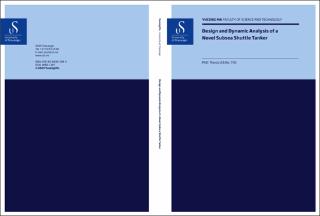| dc.description.abstract | Underwater pipelines, tanker ships, and liquefied gas carriers have traditionally been employed to transport hydrocarbons between offshore oil and gas facilities and onshore locations. However, both methods come with limitations. Underwater pipelines are costly to install and maintain, while the operation of tanker ships and liquefied gas carriers is heavily dependent on weather conditions, rendering them impractical in severe sea states. As an alternative, a pioneering subsea shuttle tanker (SST) system was proposed as an alternative for offshore transportation. The SST was designed to function at a constant speed and depth beneath the ocean surface, specifically designed for transporting liquid carbon dioxide from existing onshore/offshore sites where carbon dioxide is captured or temporarily stored, to subsea wells for reservoir injection. Nonetheless, the potential applications of the SST extend to being a versatile freight carrier, capable of transporting diverse cargoes such as subsea tools, hydrocarbons, chemicals, and even electricity.
This PhD project unfolds in two phases: design and dynamic analysis.
In the design phase, a baseline design for the SST was formulated based on existing literature. This comprehensive design encompasses critical aspects of SST design and operation, including structural design, hydrostatic stability computations, resistance and propulsion estimations, operational scenarios, and offloading methodologies. Challenges inherent to CO2 SST transportation were scrutinised, involving thermodynamic properties, purity considerations, and hydrate formation of CO2 during various vessel-transportation states. These aspects were explored in relation to cargo sizing, material selection, and energy consumption.
The second phase revolves around dynamic analysis, centred on the derived baseline SST. A manoeuvring model for the SST was constructed as a foundation. Hydrodynamic derivatives were calculated using semi-empirical formulas. Subsequently, the SST’s capability to maintain position during the offloading process was evaluated. A linear quadratic regulator was employed to address the SST’s stationkeeping challenge in stochastic currents, ensuring the vessel remains stationary during offloading. The model was further extended to explore the station-keeping under extreme current conditions, utilising probabilistic methods to predict maximum and minimum depth excursions. These predictions offer valuable insights for cost-effective SST design and operational decision-making.
The study then delved into the SST’s recoverability under undesired malfunctions through the establishment of a safety operating envelope (SOE). This envelope considered potential submersible malfunctions, such as partial flooding, jam-to-rise, and jam-to-dive incidents. By identifying feasible speed and depth ranges from an operational safety perspective, the SOE contributes to a reduction in the designed collapse depth, leading to cost savings in materials and enhanced payload capacity.
Furthermore, computational fluid dynamics (CFD) analysis was conducted to predict pressure, skin friction, drag, and lift forces affecting the SST. This included scenarios of the SST’s near-wall voyage and hovering.
Collectively, the original contributions of this thesis encompass the conceptual design, application of control systems and dynamic analysis of the SST. These contributions pave the way for future exploration in the development of commercial submarine concepts and diverse ocean space utlisation strategies. | en_US |

